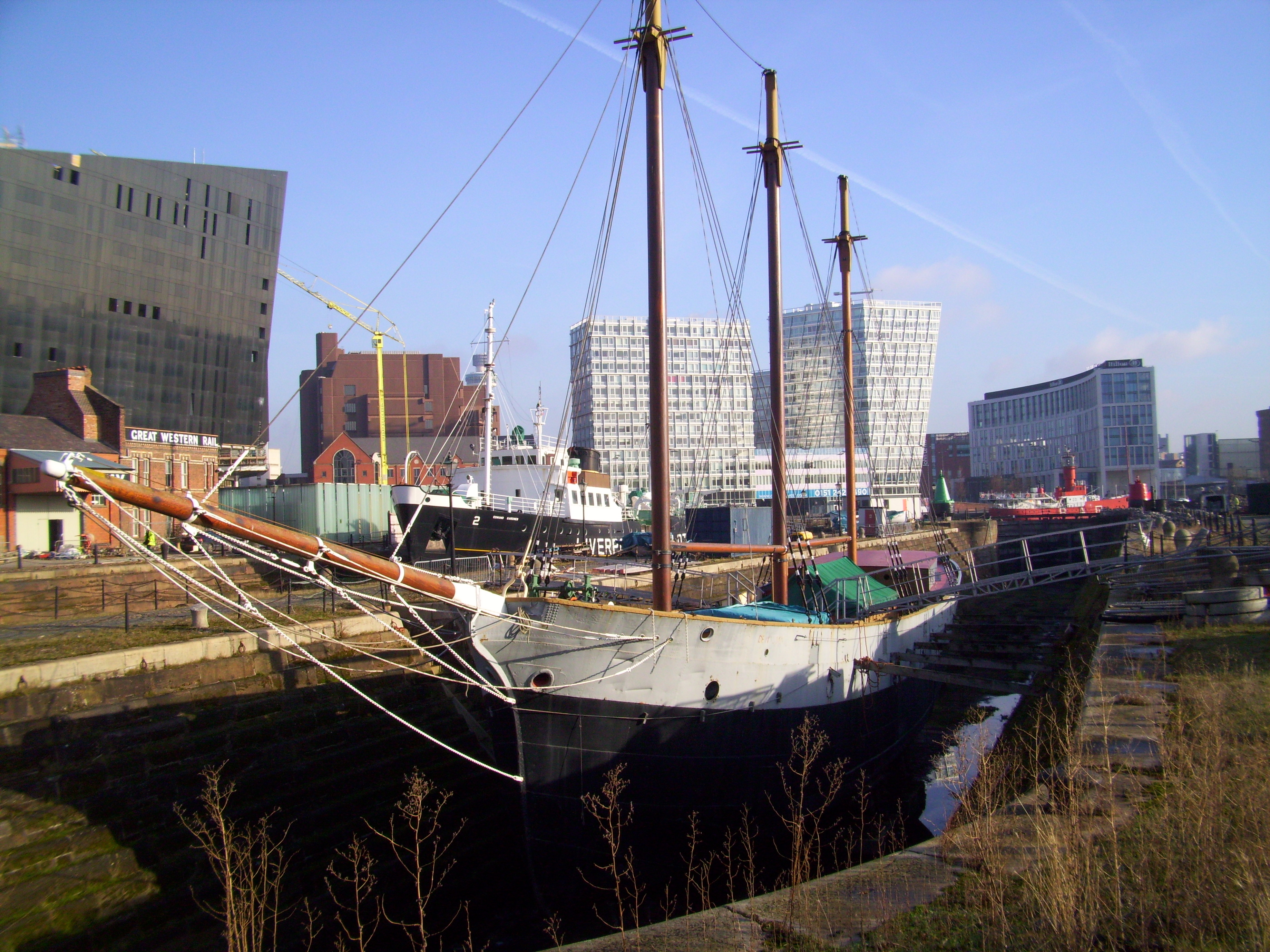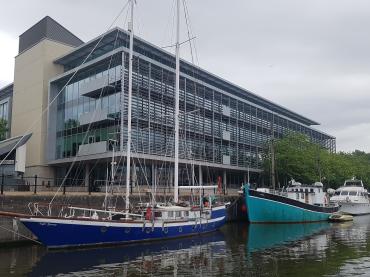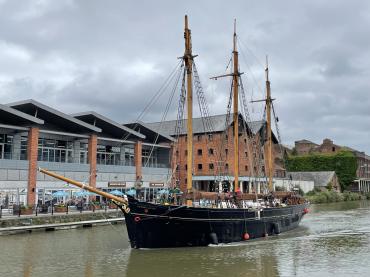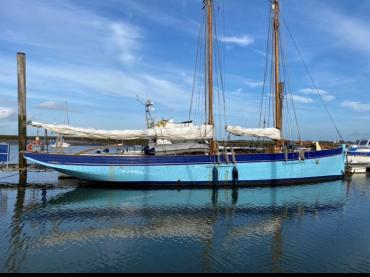
Details
Construction
Dimensions
History
DE WADDEN was a three-masted auxiliary schooner built in the Netherlands in 1917. She was built by Gebr Van Diepen of Waterhuizan, Netherlands, for the Nederlandsche Stoomvaart Maatschappij (Netherlands Steamship Company). This company commissioned DE WADDEN and her two sisters in order to take advantage of the very lucrative trading conditions created by Dutch neutrality in the First World War, and it is vessels like her which provided the foundation for the continuing Dutch strength in the European short-sea trades.
During the war the Dutch developed a new kind of coastal vessel which was a considerable advance on the traditional design of the sailing barge. They were fitted with diesel engines. British Marine Engineers were inclined to stay with the tried and tested steam designs which would, with their boilers, have been impossibly big for a power unit of a small coaster. The British were also keen to retain steam because of the plentiful supplies of steam coal. Oil had to be imported and supplies could be cut off in war time. For the Dutch, in contrast, oil was more plentiful and coal was in short supply.
The Dutch capitalised on their neutral position during the war, and Dutch shipping companies made huge profits carrying cargo for both the Germans and Allies. It had been quiet in the Dutch shipbuilding industry for the coastal trade between 1911 and 1915 but when it became clear that the Dutch could exploit their neutrality at sea a real boom started in building for the North Sea fishery and small shipping businesses. From the second half of 1915, and in 1916/17, coal and oil ran in short supply, and that was the reason why sail got her last chance.
German imports were restricted by the Allied blockade, and importers were willing to pay almost anything for all the vital merchandise that could be taken into their country through the neutral waterways of the Netherlands. Although she had been launched by 18th September 1917, DE WADDEN was still not in service in December that year. However in March 1918 she was advertised as sailing from Rotterdam to Bergen.
Her crew consisted of only five men and a boy, and since she could sail, a qualified marine engineer was not required. She carried a motor winch in the forward deckhouse to allow the cargo to be handled without extensive shore-side facilities. The motor was used almost all the time when she was under sail. This allowed the motor schooner to be built with a flat bottom and shallow draught for maximum cargo capacity together with the ability to enter small harbours. Without the push of the motor, this hull shape does not sail very well.
During the First World War, many Dutch ships were lost through torpedoing, running on mines, gunning and bombarding, and also by confiscation by both Allied and German forces. DE WADDEN’s sister ship the DE DOLLART was bound from Amsterdam to Lisbon with cargo of tobacco, cigars and Dutch gin. She called into England and France on this voyage. Whilst 8 miles south-west of Vigo (Portugal) she was sunk by the German submarine U 82. Three of the nine crew (including the Captain) died. Six survived by rowing towards land on one of the ship’s lifeboats. DE LAUWERS (like DE WADDEN) survived the war. She was sold to the Yorke Shipping Property Ltd of Adelaide in Australia.
As soon as the war’s shipping boom ended DE WADDEN’s owners sold her to Richard Hall of Arklow in the South of Ireland. The Hall family already owned a number of schooners, including the CYMRIC, and the port of Arklow was a major centre of schooner ownership.
From 1922 to 1961, DE WADDEN carried bulk cargoes such as grain, pit-props, china clay, mineral ores, and especially coal from the River Mersey to various Irish ports including Youghal and Dungarvan.
Richard Hall’s son, Victor, became her longest serving Captain, commanding her from 1933 to 1954. Her finest hour came during the Second World War when she was one of a small handful of vessels which provided the vital lifeline of supplies to the Irish Republic, after many other ships had been taken up for the British war effort.
This combination of sail and motor remained economical up to the early 1960s when she finally had to retire in favour of a modern motor coaster. She was therefore sold in Dublin and taken to Dunoon in Scotland for a new and varied career. Her tasks ranged from carrying sand to taking out fishing parties, and she appeared in a number of films, including The Onedin Line for the BBC.
She was eventually purchased by the Merseyside Maritime Museum in 1984. In 1987 she was drydocked to allow an extensive program of conservation and restoration. In the early 1990s the Museum briefly ran some onboard tours and education sessions, before this was withdrawn to allow further necessary conservation work to take place.
The world-wide shipping slump in the early 1920s forced her sale to Richard Hall of Arklow in the South of Ireland, and it is as an Irish Sea schooner that she is best remembered. From 1922 to 1961, DE WADDEN carried bulk cargoes such as grain, pit-props, china clay, mineral ores, and especially coal from the River Mersey to various Irish ports. Victor Hall, her longest serving Captain, commanded her from 1933 to 1954, and her finest hour was probably during the Second World War when she was one of a small handful of vessels which provided the vital lifeline of supplies to the Irish Republic, after many other ships had been taken up for the British war effort. Her crew consisted of only five men and a boy, and since she could sail, a qualified marine engineer was not required. She carried a motor winch in the forward deckhouse to allow the cargo to be handled without extensive shoreside facilities.
The motor was used almost all the time when she was under sail. This allowed the motor schooner to be built with a flat bottom and shallow draught for maximum cargo capacity together with the ability to enter small harbours. Without the push of the motor, this hull shape does not sail very well. Her original 125 hp 'SteyWal Dutch engine gave her a speed of five knots, but after a major failure was replaced by an 80hp Bolinder engine purchased from the Admiralty. In addition a 50 hp Kelvin engine was fitted on the port quarter to give additional power. These were both removed in January 1942 and replaced with a sic cylinder 150 hp Crossley DR diesel which was only replaced in turn by a 450 hp Caterpillar Diesel in 1980.
This combination of sail and motor remained economical up to the early 1960s when she finally had to retire in favour of a modern motor coaster. She was therefore sold in Dublin to Mr McSweeney who took her to Scotland for a new and varied career. Her tasks ranged from carrying sand to taking out fishing parties, and she even appeared in a number of films, including The Onedin Line for the BBC. She was eventually put up for sale by her last owner, Kenneth Kennedy of Dunoon, and purchased by the Merseyside Maritime Museum in 1984. In 1987 she was drydocked to allow an extensive program of conservation and restoration. In the early 1990s the Museum briefly ran some onboard tours and education sessions, before this was withdrawn to allow further necessary conservation work to take place.
In 2022, options were reviewed for De WADDEN's future and in November a declaration of intent to deconstruct was formally published by National Museums Liverpool in conjunction with NHS-UK.
Between June 2022 to February 2023, seven expressions of interest in DE WADDEN were logged from a mixture of individuals and organisations. All were offered further information, including condition surveys, site visits and formal application to progress. Of the applications that were returned none were compliant with the basic requirements for successful transfer.
In May 2023, National Museums Liverpool’s Board of Trustees approved the recording and disposal by deconstruction of DE WADDEN. A team reviewed the various options to record the vessel, from photogrammetry to exploring what elements of DE WADDEN might be suitable to retain as part of the Maritime Museum’s collections or for other potential use.
National Museums Liverpool worked with Windermere Jetty Musuem to produce a highly detailed virtual tour of the ship. Comprising more than 3,500 photographs and accompanied by high resolution panoramas, this 3D scan captured as much data as possible to produce a comprehensive digital twin/record of the ship, suitable for contemporary museum interpretation and research, and even production of a scale model if this were to be needed at a future date.
The ship’s wheel will be retained in National Museums Liverpool’s collection and a number of other elements have been identified for transfer to Arklow Maritime Museum, Ireland. National Museums Liverpool are also committed to the recycling of as much of the vessel’s materials as possible. Deconstruction began in March 2024, following a programme set out by National Historic Ships for the responsible disposal of ships. Full statement: https://www.liverpoolmuseums.org.uk/de-wadden
Significance
1. What is the vessel’s ability to demonstrate history in her physical fabric?
Evidence for designs, functions, techniques, processes, styles, customs and habits or uses and associations in relation to events and people. How early, intact or rare these features are may impact on significance.
DE WADDEN was designed with economy of crew in mind and the extra power from her diesel engine complimented her auxiliary rig. Her wide hatches facilitated the loading and discharge of cargo. During 1984-2001, conservation work was carried out on DE WADDEN by the Ship Keeping Department at the Merseyside Maritime Museum. At this time, it was decided that her role as an Irish Sea trading vessel was of primary significance and she should be restored to this specification. Therefore, alterations made at other times in her working life, such as the changes to the original main hatch coamings for her use as a sand dredger, were carefully reversed. Her level of originality remains quite high, with frames circa 90% or higher, hull plates and deck beams circa 70 - 75%, deck plating circa 60%, and her internal bulkheads predominately sound. Her poop deck coamings are replicated on the sides. The aft accommodation is formed of wood and suffered some general loss through rot, but all three separate cabins have been removed from the ship and placed into storage. The components comprise: bulkheads/deckhead furniture, doors, bunk boards, and some fittings and features largely original in layout.
2. What are the vessel’s associational links for which there is no physical evidence?
Associations with people or places. Off-ship research.
DE WADDEN was a three-masted auxiliary schooner built in the Netherlands in 1917 at a time when the Dutch were capitalising on their neutral position during the First World War, with Dutch shipping companies making huge profits carrying cargo for both the Germans and Allies. Coal and oil were in short supply, and in March 1918 she sailed between Rotterdam and Bergen. Many Dutch ships were lost through torpedoing, mines, gunning and bombarding, and also by confiscation by both Allied and German forces. DE WADDEN is a rare survivor of these vessels.
After the War she was sold to Richard Hall of Arklow in Southern Ireland and in this phase of her life, she symbolises the long history of trade between Liverpool and Ireland, and is representative of many other coastal schooners that plied their trade along the North West coast. She has strong associations to Liverpool being a frequent visitor there between 1922 and 1961, and was the last trading sailing ship to use the port. She also has great significance within the maritime history of Ireland, as one of three surviving Irish Sea schooners and the only steel auxiliary schooner.
Along with others of her kind, DE WADDEN played a part in the Second World War transporting essential supplies to Ireland. She is the last in a long line of Arklow owned and manned sail trading vessels that acted as a training ground in seamanship for local boys and men over several centuries. DE WADDEN’s significance also relates to European maritime history. She is one of the last surviving Dutch motor schooners and one of the earliest surviving of this distinctive Dutch type. She is an important example of international shipping history, representing the transitional phase between sail and diesel motor coasters developed in the 1920s. In later life, DE WADDEN developed a more popular appeal, featuring in a number of films, including The Onedin Line for the BBC.
3. How does the vessel’s shape or form combine and contribute to her function?
Overall aesthetic impact of the vessel, her lines, material she was built from and her setting. Does she remain in her working environment?
With her diesel powered riveted steel hull, three lofty masts and long graceful bowsprit DE WADDEN was well suited to her primary function as a trading schooner. She was fitted with a motor winch in the forward deckhouse which meant the cargo could be handled without extensive shore-side facilities. The motor was used almost all the time when she was under sail, allowing her to be built with a flat bottom and shallow draught which provided maximum cargo capacity together with the ability to enter small harbours. DE WADDEN is now part of the Museum of Liverpool collection and is a static dry dock exhibit in the port where she once worked.
Source: NHS-UK team, 26 August 2015. Updated 2022.
This statement was developed as part of the Heritage Lottery funded First World War project. http://www.ww1britainssurvivingvessels.org.uk/
Own this vessel?
If you are the owner of this vessel and would like to provide more details or updated information, please contact info@nationalhistoricships.org.uk














